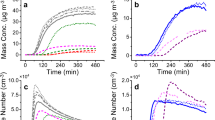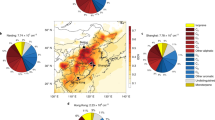Abstract
Secondary organic aerosol contributes to the atmospheric particle burden with implications for air quality and climate. Biogenic volatile organic compounds such as terpenoids emitted from plants are important secondary organic aerosol precursors with isoprene dominating the emissions of biogenic volatile organic compounds globally. However, the particle mass from isoprene oxidation is generally modest compared to that of other terpenoids. Here we show that isoprene, carbon monoxide and methane can each suppress the instantaneous mass and the overall mass yield derived from monoterpenes in mixtures of atmospheric vapours. We find that isoprene ‘scavenges’ hydroxyl radicals, preventing their reaction with monoterpenes, and the resulting isoprene peroxy radicals scavenge highly oxygenated monoterpene products. These effects reduce the yield of low-volatility products that would otherwise form secondary organic aerosol. Global model calculations indicate that oxidant and product scavenging can operate effectively in the real atmosphere. Thus highly reactive compounds (such as isoprene) that produce a modest amount of aerosol are not necessarily net producers of secondary organic particle mass and their oxidation in mixtures of atmospheric vapours can suppress both particle number and mass of secondary organic aerosol. We suggest that formation mechanisms of secondary organic aerosol in the atmosphere need to be considered more realistically, accounting for mechanistic interactions between the products of oxidizing precursor molecules (as is recognized to be necessary when modelling ozone production).
This is a preview of subscription content, access via your institution
Access options
Access Nature and 54 other Nature Portfolio journals
Get Nature+, our best-value online-access subscription
$29.99 / 30 days
cancel any time
Subscribe to this journal
Receive 51 print issues and online access
$199.00 per year
only $3.90 per issue
Buy this article
- Purchase on Springer Link
- Instant access to full article PDF
Prices may be subject to local taxes which are calculated during checkout





Similar content being viewed by others
Data availability
All data used are shown as figures or tables in the manuscript or in Supplementary Information. Raw data are available from the corresponding author on reasonable request.
References
Hallquist, M. et al. The formation, properties and impact of secondary organic aerosol: current and emerging issues. Atmos. Chem. Phys. 9, 5155–5236 (2009).
Jimenez, J. L. et al. Evolution of organic aerosols in the atmosphere. Science 326, 1525–1529 (2009).
Goldstein, A. H. & Galbally, I. E. Known and unexplored organic constituents in the Earth’s atmosphere. Environ. Sci. Technol. 41, 1514–1521 (2007).
Spracklen, D. V. et al. Aerosol mass spectrometer constraint on the global secondary organic aerosol budget. Atmos. Chem. Phys. 11, 12109–12136 (2011).
Kanakidou, M. et al. Organic aerosol and global climate modelling: a review. Atmos. Chem. Phys. 5, 1053–1123 (2005).
Guenther, A. et al. Estimates of global terrestrial isoprene emissions using MEGAN (Model of Emissions of Gases and Aerosols from Nature). Atmos. Chem. Phys. 6, 3181–3210 (2006).
Guenther, A. et al. The Model of Emissions of Gases and Aerosols from Nature version 2.1 (MEGAN2.1): an extended and updated framework for modeling biogenic emissions. Geosci. Model Dev. 5, 1471–1492 (2012).
Carlton, A. G., Wiedinmyer, C. & Kroll, J. H. A review of secondary organic aerosol (SOA) formation from isoprene. Atmos. Chem. Phys. 9, 4987–5005 (2009).
Clark, C. H. et al. Temperature effects on secondary organic aerosol (SOA) from the dark ozonolysis and photo-oxidation of isoprene. Environ. Sci. Technol. 50, 5564–5571 (2016).
Liu, J. et al. Efficient isoprene secondary organic aerosol formation from a non-IEPOX pathway. Environ. Sci. Technol. 50, 9872–9880 (2016).
Edney, E. O. et al. Formation of 2-methyl tetrols and 2-methylglyceric acid in secondary organic aerosol from laboratory irradiated isoprene/NOx/SO2/air mixtures and their detection in ambient PM2.5 samples collected in the eastern United States. Atmos. Environ. 39, 5281–5289 (2005).
Surratt, J. D. et al. Reactive intermediates revealed in secondary organic aerosol formation from isoprene. Proc. Natl Acad. Sci. USA 107, 6640–6645 (2010).
Claeys, M. et al. Formation of secondary organic aerosols from isoprene and its gas-phase oxidation products through reaction with hydrogen peroxide. Atmos. Environ. 38, 4093–4098 (2004).
Robinson, N. H. et al. Evidence for a significant proportion of secondary organic aerosol from isoprene above a maritime tropical forest. Atmos. Chem. Phys. 11, 1039–1050 (2011).
Xu, L. et al. Effects of anthropogenic emissions on aerosol formation from isoprene and monoterpenes in the southeastern United States. Proc. Natl Acad. Sci. USA 112, 37–42 (2015).
Lee, A. et al. Gas-phase products and secondary aerosol yields from the ozonolysis of ten different terpenes. J. Geophys. Res. 111, D07302 (2006).
Lee, A. et al. Gas-phase products and secondary aerosol yields from the photooxidation of 16 different terpenes. J. Geophys. Res. 111, D17305 (2006).
Ng, N. L. et al. Effect of NOx level on secondary organic aerosol (SOA) formation from the photooxidation of terpenes. Atmos. Chem. Phys. 7, 5159–5174 (2007).
Kiendler-Scharr, A. et al. New particle formation in forests inhibited by isoprene emissions. Nature 461, 381–384 (2009).
Kanawade, V. P. et al. Isoprene suppression of new particle formation in a mixed deciduous forest. Atmos. Chem. Phys. 11, 6013–6027 (2011).
Lee, S. H. et al. Isoprene suppression of new particle formation: Potential mechanisms and implications. J. Geophys. Res. Atmos. 121, 14621–14635 (2016).
Ehn, M. et al. A large source of low-volatility secondary organic aerosol. Nature 506, 476–479 (2014).
Jenkin, M. E., Derwent, R. G. & Wallington, T. J. Photochemical ozone creation potentials for volatile organic compounds: rationalization and estimation. Atmos. Environ. 163, 128–137 (2017).
Odum, J. R. et al. Gas/particle partitioning and secondary organic aerosol yields. Environ. Sci. Technol. 30, 2580–2585 (1996).
Hoffmann, T. et al. Formation of organic aerosols from the oxidation of biogenic hydrocarbons. J. Atmos. Chem. 26, 189–222 (1997).
Seinfeld, J. H. & Pankow, J. F. Organic atmospheric particulate material. Annu. Rev. Phys. Chem. 54, 121–140 (2003).
Matsunaga, A. & Ziemann, P. J. Gas-wall partitioning of organic compounds in a Teflon film chamber and potential effects on reaction product and aerosol yield measurements. Aerosol Sci. Technol. 44, 881–892 (2010).
Zhang, X. et al. Influence of vapor wall loss in laboratory chambers on yields of secondary organic aerosol. Proc. Natl Acad. Sci. USA 111, 5802–5807 (2014).
Zhang, X. et al. Vapor wall deposition in Teflon chambers. Atmos. Chem. Phys. 15, 4197–4214 (2015).
Krechmer, J. E., Pagonis, D., Ziemann, P. J. & Jimenez, J. L. Quantification of gas-wall partitioning in Teflon environmental chambers using rapid bursts of low-volatility oxidized species generated in situ. Environ. Sci. Technol. 50, 5757–5765 (2016).
Sarrafzadeh, M. et al. Impact of NOx and OH on secondary organic aerosol formation from β-pinene photooxidation. Atmos. Chem. Phys. 16, 11237–11248 (2016).
Eddingsaas, N. C. et al. Alpha-pinene photooxidation under controlled chemical conditions—Part 2: SOA yield and composition in low- and high-NOx environments. Atmos. Chem. Phys. 12, 7413–7427 (2012).
Zhang, X., Pandis, S. N. & Seinfeld, J. H. Diffusion-limited versus quasi-equilibrium aerosol growth. Aerosol Sci. Technol. 46, 874–885 (2012).
O’Meara, S., Topping, D. O. & McFiggans, G. The rate of equilibration of viscous aerosol particles. Atmos. Chem. Phys. 16, 5299–5313 (2016).
Surratt, J. D. et al. Effect of acidity on secondary organic aerosol formation from isoprene. Environ. Sci. Technol. 41, 5363–5369 (2007).
Gaston, C. J. et al. Reactive uptake of an isoprene-derived epoxydiol to submicron aerosol particles. Environ. Sci. Technol. 48, 11178–11186 (2014).
Riva, M. et al. Effect of organic coatings, humidity and aerosol acidity on multiphase chemistry of isoprene epoxydiols. Environ. Sci. Technol. 50, 5580–5588 (2016).
Berndt, T. et al. Accretion product formation from self- and cross-reactions of RO2 radicals in the atmosphere. Angew. Chem. Int. Ed. 57, 3820–3824 (2018).
Tröstl, J. et al. The role of low-volatility organic compounds in initial particle growth in the atmosphere. Nature 533, 527–531 (2016).
Mohr, C. et al. Ambient observations of dimers from terpene oxidation in the gas phase: implications for new particle formation and growth. Geophys. Res. Lett. 44, 2958–2966 (2017).
Yan, C. et al. Source characterization of highly oxidized multifunctional compounds in a boreal forest environment using positive matrix factorization. Atmos. Chem. Phys. 16, 12715–12731 (2016).
Wennberg, P. O. et al. Gas-phase reactions of isoprene and its major oxidation products. Chem. Rev. 118, 3337–3390 (2018).
Simpson, D. et al. The EMEP MSC-W chemical transport model—technical description. Atmos. Chem. Phys. 12, 7825–7865 (2012).
Stadtler, S. et al. Ozone impacts of gas-aerosol uptake in global chemistry-transport models. Atmos. Chem. Phys. 18, 3147–3171 (2018).
Acknowledgements
The EMEP modelling work was funded partially by EMEP under UNECE. Computer time for EMEP model runs was supported by the Research Council of Norway through the NOTUR project EMEP (NN2890K) for the central processing unit (CPU) time, and NorStore project European Monitoring and Evaluation Programme (NS9005K) for storage of data. The research presented is a contribution to the Swedish strategic research area ‘ModElling the Regional and Global Earth system’ (MERGE). This work was supported by Formas (grant numbers 214-2010-1756 and 942-2015-1537); the Swedish Research Council (grant number 2014-5332) and the European Research Council (Starting grant number 638703, ‘COALA’). Å.M.H. acknowledges Formas (grant number 214-2013-1430) and Vinnova, Sweden’s Innovation Agency (grant number 2013-03058), including support for her research stay at Forschungszentrum Jülich. The participation of the Manchester group was facilitated by the UK Natural Environment Research Council (NERC)-funded CCN-Vol project (NE/L007827/1) and National Centre for Atmospheric Science (NCAS) funding. J.A.T. was supported by a grant from the U.S. Department of Energy Office of Science: DE-SC0018221.
Reviewer information
Nature thanks F. Yu, P. Ziemann and the other anonymous reviewer(s) for their contribution to the peer review of this work.
Author information
Authors and Affiliations
Contributions
G.M., T.F.M. and J.W. edited the manuscript and Supplementary Information. G.M., T.F.M., J.W., A.K.-S., M.H., D.S. and M.E.J. conceptualized and planned the study, and conducted data interpretation. J.W., I.P., S.K., E.K., S.S., M.S., R.T., C.W., D.Z., C.F., M.L.B., Å.M.H., M.R.A., T.J.B., C.J.P., M.P. and D.T. conducted data collection and analysis. D.S., R.B. and M.E.J. contributed the global model calculations. J.A.T., M.E., Å.M.H. and M.H. provided specific inputs to the manuscript and Supplementary Information. All co-authors discussed the results and commented on the manuscript and Supplementary Information.
Corresponding author
Ethics declarations
Competing interests
The authors declare no competing interests.
Additional information
Publisher’s note: Springer Nature remains neutral with regard to jurisdictional claims in published maps and institutional affiliations.
Extended data figures and tables
Supplementary Information
The supplement contains one single pdf file. The material is ordered in 9 sections, which describe in detail the experiments and the applied methods. It contains Figures (17) and Tables (5), and additional references (69). The supplement provides all additional information which informed our findings
Rights and permissions
About this article
Cite this article
McFiggans, G., Mentel, T.F., Wildt, J. et al. Secondary organic aerosol reduced by mixture of atmospheric vapours. Nature 565, 587–593 (2019). https://doi.org/10.1038/s41586-018-0871-y
Received:
Accepted:
Published:
Issue Date:
DOI: https://doi.org/10.1038/s41586-018-0871-y
This article is cited by
-
Reactive aldehyde chemistry explains the missing source of hydroxyl radicals
Nature Communications (2024)
-
Process-evaluation of forest aerosol-cloud-climate feedback shows clear evidence from observations and large uncertainty in models
Nature Communications (2024)
-
Fossil and non-fossil sources of the carbonaceous component of PM2.5 in forest and urban areas
Scientific Reports (2023)
-
High-latitude vegetation changes will determine future plant volatile impacts on atmospheric organic aerosols
npj Climate and Atmospheric Science (2023)
-
Atmospheric new particle formation from the CERN CLOUD experiment
Nature Geoscience (2023)
Comments
By submitting a comment you agree to abide by our Terms and Community Guidelines. If you find something abusive or that does not comply with our terms or guidelines please flag it as inappropriate.



